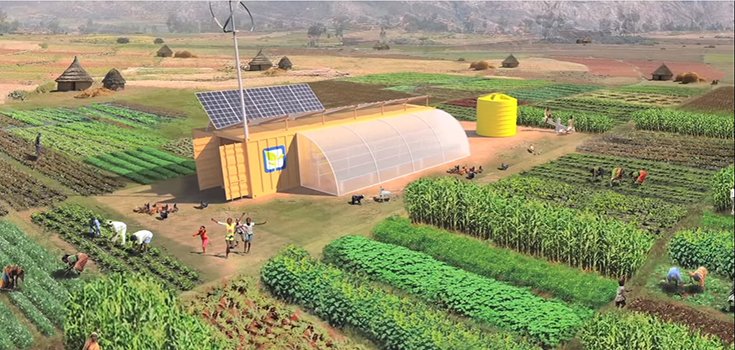Think Outside the Box: 2-Acre Shipping-Container Farm Feeds 150

I grew up surrounded by farmland and lived near rural Tennessee for a time, yet I wouldn’t have the foggiest idea how to start a farm. But if I wanted to experience farming on a small scale, Farm From the Box would be the way to go. The tiny house movement has shown us that shipping containers can be turned into stylish homes, and 2-acre farms capable of feeding 150 people come in shipping containers, too.
Read: Study Proves Sustainable Farms, Organic Farming Beats Factory Farms
Marko Wittich, SMA executive vice president of sales for the Americas region, said:
“SMA is proud to partner with a company whose goal is to bring independence to communities around the globe by providing the tools they need to sustain themselves, both nutritionally and financially. Farm from a Box isn’t charity; it empowers and strengthens communities with sustainable solutions, powered by renewable energy.” [1]
Farm From a Box comes with a training program that teaches ecological farming practices, technology use, maintenance, and basic business and entrepreneurship. The $25,000-$45,000 farms are also fully customizable. [1]
Read: 4 Ways to Heal and Replenish Damaged Soil and the Food Supply
Said DeCarli:
“Farm From a Box is the ‘Swiss-Army knife’ of sustainable farming.
Based on extensive field research, we found that rural communities often lack the resources and infrastructure needed to access nutritious food. We developed a toolkit that contains all of the core components needed to grow your own food, on a two acre plot of land, without the need for an existing grid.
Imagine the good it can do by growing local, organic food for a school, or helping jump-start food production after a disaster. ‘Farm from a Box’ enables and empowers communities to provide for themselves.” [1]
All Farm From the Box kits are solar-powered and include 3 kW of solar energy capacity – enough to power the water pump and WiFi connectivity that allows farm conditions to be monitored remotely. [2]
There is more than enough energy, so there is no need to be connected to the electric grid.
Sources:
[1] Eco Watch
